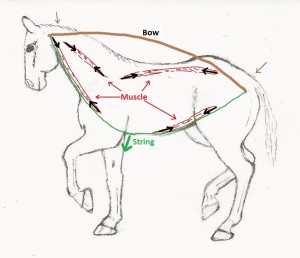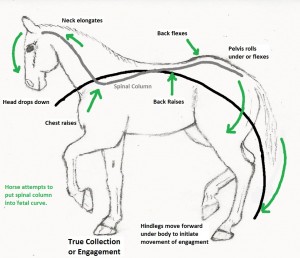Equine biomechanics of locomotion gives us a basic understanding of our horse’s ability to function or compete and why they develop lameness. Using the information discussed in this first of four blog posts, we can reduce or eliminate the loss of riding or competing with our athletic equine companions and partners. Lameness is a major cause of loss of function for our horses. The causes of lameness originate from three major areas: repetitive stress orthopedic injuries, soft tissue injuries or blunt trauma. Blunt trauma injuries often stem from unpredictable circumstances which are difficult to predict and avoid. Conversely repetitive stress orthopedic injuries or soft tissue injuries are lameness areas which can be reduced or avoided. Having an understanding of some basic equine biomechanical locomotion perimeters helps us to avoid loss due to lameness.
Equine Locomotion:
To understand equine biomechanics of locomotion, we need to know some basic definitions and location of areas on the horse. To begin, locomotion is the ability to move the center of gravity in a given direction. The center of gravity is usually moved with one of a multitude of gaits. A gait is defined as a consistent coordinated movement of the legs created by the muscles action on the bones in a set repeatable pattern. The center of mass is the exact point in the body where the weight of the horse is balanced on the end of a pencil. For horses the center of mass is located in the chest behind the front leg and above the elbow.
When the horse is standing still the center of mass and the center of gravity are at the same point. In order to produce motion the center of gravity has to be moved and the center of mass will move to catch up with the center of gravity. The movement of the center of gravity is produced by muscle contraction and storing of potential energy in the Bow and String Mechanism and the Stay Apparatus of the horse. In equine biomechanics, horses are hind end powered or driven animals with a bow and string apparatus to conserve and provide potential energy.
Bow and String Theory:

In the bow and string apparatus, the bow is the spine, spinal ligament and the intrinsic muscles of the horse’s spine. The string is the ventral or lower spinal muscles along with the abdominal muscles and lower neck muscles. To initiate locomotion, the center of gravity is moved backwards by moving the hind leg forward under the abdomen along with tightening the string of the bow. This action tilts the tail end of the pelvis down and the head end up. Since there is no top ligament between the sacrum and last lumbar vertebra, a larger tilt of the pelvis occurs producing a longer hind

leg stride. This mechanical advantage provides a larger length of pull and power for the hind legs to drive the center of gravity forward. As the pelvis tilts the thoracolumbar spine elevates; upper thoracic and lower cervical spinal curvature straightens as the neck elongates and curves to allow a further tightening of the string.
Since the hind legs are on the ground and front half elevated when the string is released, the stored energy in the spine, spinal muscle, spinal ligaments are released along with contraction of the large muscles of the back and hind legs powers the horse forward.
Resetting the Bow and String for the next stride:
As the forelegs land on the ground the energy of contact is dissipated in the hoof, ligaments, circulatory systems and elastic muscle components. The force of ground contact is stored in the stay apparatus of the forelegs as potential energy. To clarify, the stay apparatus of the fore legs consists of the suspensory ligament apparatus, superficial and deep digital flexor tendons and elastic leg muscle components, along with their check ligaments, bones and other elastic muscle components of the fore quarters. The design and placement of the ligaments, check ligaments, tendons and elastic muscle components allows the horse to lock the leg and transfer energy into the larger muscle of the foreleg and components of the bow and string apparatus. This movement of the foreleg pushes the components of the bow allowing easier contraction of the string components to reset bow and string apparatus for the next stride.
Complex biomechanical movement in equine locomotion:
Even with this brief description of equine biomechanics, one can see the complex interaction of nerves, muscles, tendons, ligaments, and bones. The coordination of these structures by the nervous system are of the utmost importance to move the center of gravity and produce a gait. Built into the system are checks and balances to preserve the equine biomechanics for the next step or athletic function, but the system must have coordination to work properly. If the biomechanics are not evaluated and monitored by the nervous system, protected in it’s flexion and extension of joints, stabilized in its bone and joint movement, the system will breakdown. When the nervous system is not functioning to its potential of evaluation and monitoring, the checks and balances of motion and stabilization are not working to their maximum to protect the horse from breakdown or lameness. With the loss of nervous system monitoring and function, stabilization of the joints is lost. With the loss of stabilization joint and soft tissue injury develop. In future blogs we will discuss True Collection, False Collection, Developing Lameness and the role of the nervous system in regards to the check and balances and how reduced function leads to lameness or loss of function of your horse.

[…] K., 2016. Equine Biomechanics and Locomotion. Keith Wagner Equine Veterinarian [online]. Available: https://wagnerhorsedoc.com/equine-biomechanics-locomotion/ [accessed […]
[…] K., 2016. Equine Biomechanics and Locomotion. Keith Wagner Equine Veterinarian [online]. Available: https://wagnerhorsedoc.com/equine-biomechanics-locomotion/ [accessed […]